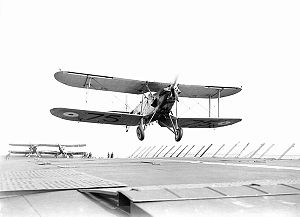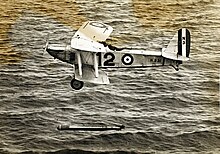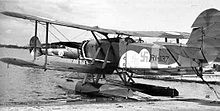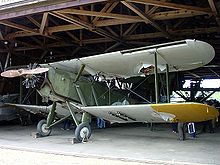Blackburn Ripon
| Blackburn Ripon | |
|---|---|

|
|
| Type: | carrier-based reconnaissance aircraft and torpedo bomber |
| Design country: | |
| Manufacturer: | |
| First flight: |
April 17, 1926 |
| Commissioning: |
July 1929 |
| Production time: |
1926-1934 |
| Number of pieces: |
98 + 25 under license |
The Blackburn T.5 Ripon was a two - seat carrier-based reconnaissance aircraft and torpedo bomber used by the British naval aviators, which were still part of the Royal Air Force during the aircraft's service life from 1929 to 1935 .
One machine was sold to Finland, where another 25 were manufactured under license. These machines remained in use in the Winter War and Continuation War until 1944 . One of the Finnish machines was preserved.
Development of the Blackburn Ripon
The Blackburn Ripon was designed to replace the single-seat Blackburn Dart torpedo bombers in the units of the British aircraft carriers. With the specification 21/23 , the British Ministry of Aviation required a machine that should also take on long-range reconnaissance tasks and required a crew of two. The first flight of the Blackburn Ripon prototype N203 with land landing gear took place on April 17, 1926. On August 26th of the same year the 2nd prototype N204 flew as a float version of the type.
The comparison tests showed that the competitors Handley Page Harrow and Avro Buffalo did not satisfy, but the Ripon did not meet the requirements either and had to be improved further. A modified installation of the drive, slightly more swept-back wings and an improved tail unit were required. After these improvements in a new prototype N231 , the Ripon Mk.II developed from the Dart was accepted and a production order according to description 2/29 was placed, which was followed by others with renewed requests for changes. The aircraft was designed very conventionally: it was still a largely wooden biplane with an open cockpit, in- line engine and rigid landing gear. Only when Ripon Mk.IIc the wood has been trussed by one made of steel and duralumin replaced.
The Navy Air Force , at that time still part of the Royal Air Force , received the following versions:
- T.5 Ripon Mk.I
- equipped with a 465 hp Napier Lion V engine, two prototypes in 1926
- T.5 Ripon Mk.II
- first series version equipped with Lion XI engines; 21 machines ordered between November 1927 and January 1929.
- T.5 Ripon Mk.IIa
- Series version and 570 PS (347 kW) Lion XIA engines equipped, wings with metal frame, now with a rigid MG to the front; 40 machines ordered in two lots in 1930. S1268 and S1468 tested with floats
- T.5 Ripon Mk.IIc
- second series version equipped with Lion XI engines, metal wing spar; 31 machines and conversions of some older versions.
- T.5 Ripon Mk.III
- single prototype S1272 with Lion XI in an extended nose, fuselage with metal frame , new wing tips and new tail unit; Ordered in 1928, first flight in January 1930
- B.4 Ripon Mk.IV
- single prototype 1932 with Armstrong Siddeley Tiger twin radial engine.
- B.5 Ripon Mk.V
- single prototype 1932 with 565 HP Bristol Pegasus star engine; Prototype of the successor Blackburn Baffin
Used by the British Fleet Air Force
Since April 1, 1923, the Royal Air Force organized its units intended for combat at sea in special flights (swarms) for the use of aircraft carriers. At the end of 1928 there were five "Fleet Torpedo Flight" s ( 460 to 464 ), each equipped with six Blackburn Darts as emergency aircraft.
The Furious Flight 462 was the first to receive the new Blackburn Ripon Mk.II for the Dart in February 1929, followed by the Flight 461 , which was used on the same carrier, at the turn of the year . In May 1930, both units switched to the Glorious , which had just been commissioned after its conversion to an aircraft carrier , while the Furious was about to be converted again. The two flights formed the new 812 torpedo bomber squadron on March 3, 1933, now equipped with newer Ripon Mk.IIc , when the RAF changed the organizational structure of their units for the aircraft carriers. The new squadron was with the Glorious in the Mediterranean Fleet, along with squadrons 802 with Hawker Nimrod and Osprey fighter aircraft and 823 with Fairey IIIF scouts.
In November 1930 and the flight then received 460 on the HMS Eagle , the Blackburn Ripon Mk.II . On January 8, 1931, the aircraft carrier left Malta to demonstrate British aircraft on the occasion of the "British Empire Trade Exhibition" held abroad for the first time. The exhibition in Buenos Aires opened on March 14th of the Prince of Wales , whose De Havilland DH.80 Puss Moth was also transported on the carrier. The Eagle had an additional flight with new machines on board, such as the Hawker fighter aircraft Nimrod and Osprey , the prototype of the new reconnaissance aircraft Fairey Seal and another Ripon . It is unclear whether the carrier's three other flights ( 402 with Fairey Flycatcher fighter planes and 440 and 448 with Fairey IIIF scouts) remained on board in addition to Flight 460 . The special flight and the carrier's machines made demonstration flights not only in Buenos Aires, but also in Montevideo and Rio de Janeiro on the return journey . The Eagle then returned to the Mediterranean and gave the Flight 460 in May 1931 to the HMS Glorious , which had three torpedo bomber units.
In March and April 1931 two flights with Blackburn Ripon Mk.IIc had already been set up: the 465 and 466 were both intended for the HMS Furious , which came back into service in May after an overhaul and in November 1931 as the second carrier to the Home Fleet kicked. These two flights were then merged into one season ( 811 ) in April 1933 .
In November 1932, the number of Ripons on the carriers decreased when 460 on the Glorious traded torpedo bombers for Fairey IIIF scouts. In September 1933, the torpedo bomber squadron 810 on the HMS Courageous, still equipped with Blackburn Darts , exchanged part of their machines for Blackburn Ripon Mk.IIc without ever being completely converted. In the summer of 1934, the squadron was equipped as a second unit with the successor Blackburn Baffin . Previously, the 812 squadron of the Glorious had received the new type of mission in January 1934 in Hal Far on Malta. The season 811 of the Furious was the last season in January 1935 from their Ripons and received new Baffins .
So ended the service time of the Blackburn Ripon in the squadrons of the 1st line after six years.
In Finnish service
Contrary to the manufacturer's expectations, especially after the Eagle 's trip to South America , the model could only be sold to Finland , where it was also manufactured under license .
- T.5 Ripon Mk.IIF
- Sample aircraft for the Finnish Air Force, tested with Armstrong-Siddeley Panther and Bristol Jupiter star engine built by Gnome-Rhone . 25 licensed buildings.
After initial difficulties, the Finnish State Aircraft Factory Valtion lentokonetehdas produced three series of seven, eight and ten machines until 1934. The greatest difficulties were in the selection of a suitable engine. The RI 121 sample machine delivered in September 1929 had a Bristol Jupiter VI of 530 hp.
The first series ( RI 129-RI 135 ) was therefore equipped with Gnome-Rhone- Jupiter VI licensed builds, but they only made 480 hp and did not prove themselves. The second to fourth machines were therefore given other engines for test purposes, such as a 575 HP Wright Cyclone , a 535 HP Armstrong-Siddeley Panther and a 525 HP BMW 132 A Hornet. The second series ( RI 136-RI 143 ) was then equipped with the Armstrong-Siddeley Panther double radial engines. In the third series ( RI 150-RI 159 ) another engine change took place. These machines received 580 HP Bristol Pegasus IIM engines, some of which were also installed in older machines during major overhauls. The last Finnish Ripon RI-159 was the only one equipped with a liquid-cooled 650 HP Hispano-Suiza 12. The machines were also used as float planes. In 1939 the Finnish Air Force planned to replace the machines with twin-engine Fokker T.VIII-Ws , which did not occur due to the war.
The Finnish Ripon s remained in service in the Winter War 1939/40 and in the Continuation War 1941/44. At the beginning of the Winter War there were still 21 machines in existence. Nine machines were primarily used for the LeLv 16 reconnaissance and bomber squadron and six float planes for the LeLv36 for sea reconnaissance. Four machines were lost in the course of the war, three more in the Continuation War. At that time, the Ripon was only used on the LeLv 6 (ex 36 ) alongside other seaplanes. The other Ripons were used as liaison or ambulance aircraft. In the course of the war, almost all machines were damaged and sorted out as no longer worth repairing. The last flight of a Finnish Ripon was on February 16, 1945 by RI-156 .
The museum plane
A Blackburn Ripon (registration number: RI-140) was restored by the Finnish Päijät-Häme Aircraft Museum in Lahti and presented to the public on May 19, 2006.
The RI-140 was delivered as a second series machine on November 12, 1931. After an emergency landing on November 1, 1941, it was repaired again and used for surveillance flights over sea. In bad condition it was handed over to the Airforce Depot at the end of August and canceled after 1261.5 flight hours. But it remained in the depot and was overhauled from 2005 to be exhibited in the museum.
Technical specifications
| Parameter | Data Blackburn Ripon IIA |
|---|---|
| crew | 2 |
| length | 11.20 m |
| span | 13.67 m |
| Wing area | 63.45 m² |
| height | 3.91 m |
| Empty mass | 1930 kg |
| Takeoff mass | 3359 kg |
| drive | a 12-cylinder Y-engine Napier-Lion XIA with 578 hp |
| Top speed | 203 km / h at sea level |
| Max. Range | 1706 km |
| Service ceiling | 3050 m |
| Armament | two 7.7 mm machine guns , bombs up to 680 kg or a torpedo |
See also
literature
- David Brown: HMS Eagle , Warship Profile 35, 1973
- William Green: Bombers and Reconnaissance Aircraft , Volume 7, Macdonald London, 1967
- CA Jenkins: HMS Furious , Warship Profile 23/24, 1972
- Peter Lewis: The British Bomber since 1914 , Putnam London, 3rd edition 1980, ISBN 0-370-30265-6
- Kenneth Munson: Bomber 1919–1939 , Orell Füssli; Zurich, 1971
- Ray Sturtivant: The Squadrons of the Fleet Air Arm , Air-Britain Tonbridge, 1984, ISBN 0-85130-120-7
Web links
- Blackburn Rippon of the Finnish Army with a BMW Hornet aircraft engine. BMW Group Archive, accessed on September 25, 2009 .
- Blackburn Ripon (Engl.)
- Blackburn T.5 Ripon (engl.)
- Photos of Blackburn Ripon III in Flight
- Pictures for the processing of the preserved Ripon (Finnish)
- Details of the Finnish Blackburn Ripon (Finnish)
- Model of the Blackburn Ripon and Baffin (engl.)




